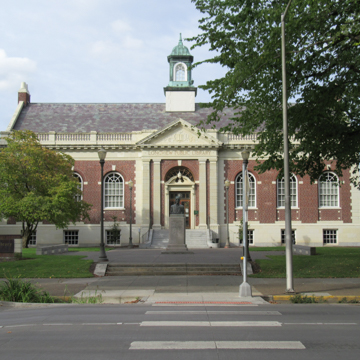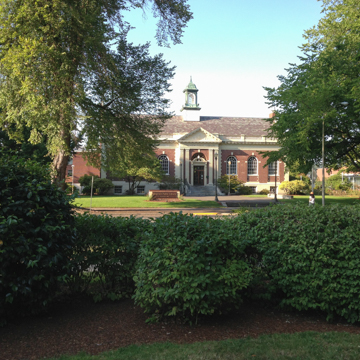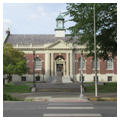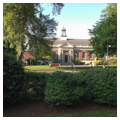The Longview Public Library, on axis with the northern edge of the city’s central park, is integral to the model city of Longview as it was envisioned by R.A. Long and his Kansas City–based planning firm, Hare and Hare. Of all the structures in Longview directly related to either the Long-Bell Lumber Company or Long himself, the library, completed in 1926, was undoubtedly the one structure most personally significant to Long, the city’s founder.
Together with many of his peers, Long recognized the importance of self-improvement, even after formal schooling was completed. To this end, he paid for the original Georgian Revival library building out his personal funds and funded its operating costs for the first several years of its existence. The building features a somewhat traditional Georgian Revival design, with six Palladian windows flanking either side of an arched entryway surrounded by a stone classical temple front with a large pediment and Doric pilasters. A stone balustrade serves as the base of the roofline, although the facade is mostly red brick. A cupola tops the structure. The original layout of the library had reading rooms arranged across the front of the building flanking the central checkout desk, with the book stacks located in north (rear) wing. The original detailing of the reading rooms still survives.
The library justified Long’s commitment when it became the first home for the Lower Columbia Valley College, founded in 1935. In 1953, the library’s interior was remodeled by Kenneth C. Woolen, who was also later responsible for a major 1967–1968 addition attached to the rear of the original building. This expanded the library’s capacity and enabled it to better serve the city’s growing population. As the building approached its 75th anniversary, its rehabilitation was overseen by David Strauss of Cardwell Thomas and Associates in 2000–2001.
In 2002, the two-piece sculpture group Storytime by De L’Esprie was installed on the east side of the entrance plaza. More recently, in late 2015, the commemorative bust of R.A. Long (1946) by Victor Alonzo Lewis and its 1942 pedestal were relocated from the adjacent park to the entrance plaza and aligned with main entrance to the library.
The cupola’s significance has become iconic, as it has been employed by the Longview Historic Preservation Board for many of the plaques that identify buildings placed on the Longview Register of Historic Places.




